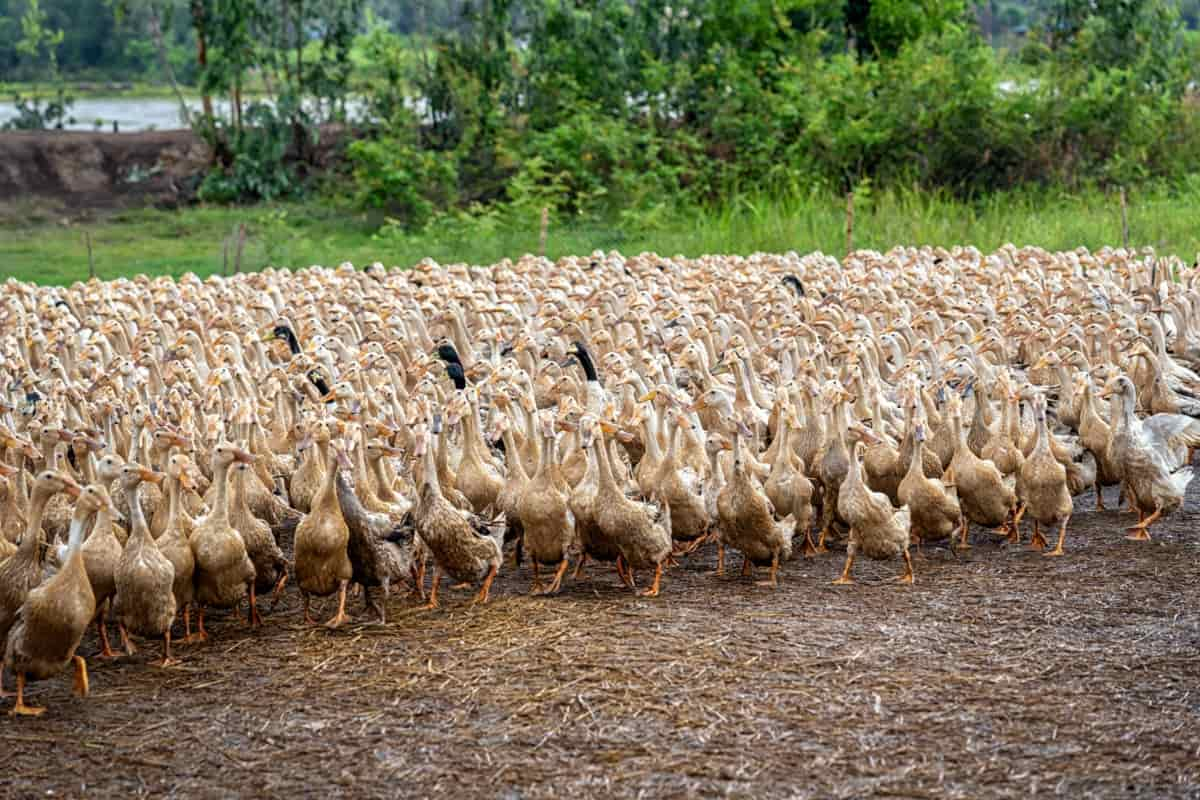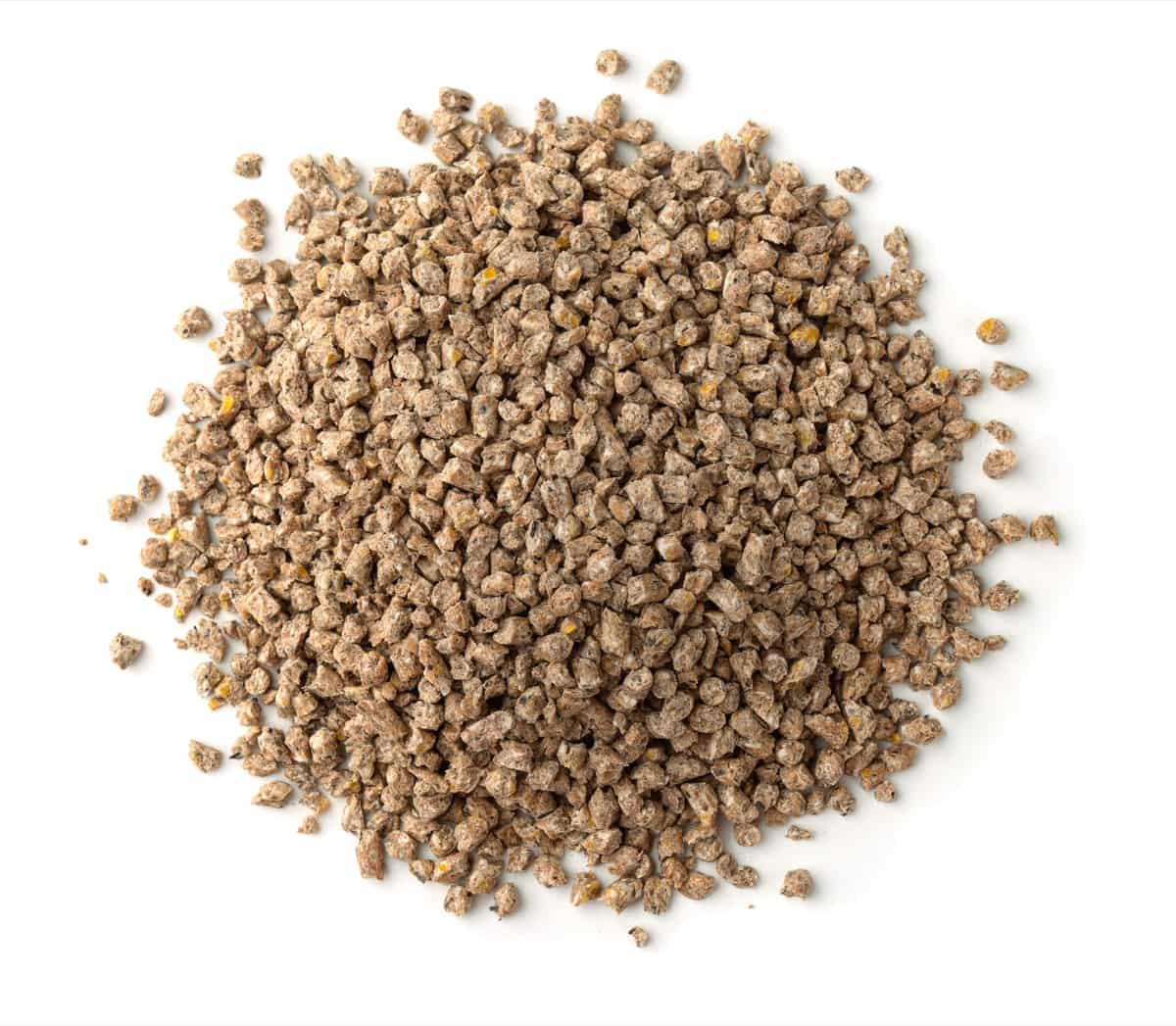Usually, ducks are raised as pets on small ponds or lakes for release in hunting preserves, conservation areas, or for consumption. Raising healthy ducks requires a combination of good nutrition and proper management. With commercially prepared diets, maximum growth and reproduction efficiency can be achieved.

The majority of local feed stores carry good commercial duck feed. Mixing the complete feed on the farm may be less expensive for large duck operations than purchasing it from a commercial source. Whether the feed is purchased or mixed on the farm, it must be stored in a clean, dry place away from rodents and insects to prevent contamination.
Feed Management in Ducks
Feed Materials for Feeding Ducks
- As a meal, grains contain carbohydrates that can be fed whole or ground. You can feed birds corn, rice, maize, barley, oats, sorghum, finger millet, bulrush millet, or bran from rice.
- A cake made from groundnuts, cottonseed, or dates can also provide carbohydrates and protein. Protein is also found in soya bean meals. Plants provide these types of protein-rich feed, while animal products such as fish meal, milk powder, and dried blood also provide protein.
- Birds should not be given too much animal protein. Besides being expensive, it can cause animal diseases if too much is used. A lot of fish meal can make eggs taste fishy.
- Cottonseed, groundnuts, and sunflower seeds contain fats.
- Minerals can be found in a bone meal (ground bone), egg shells, and old seashells, which can be ground and added to feed. A good source of minerals is cuttlefish bone if it is available locally
- Vitamins may be added to the feed by adding green plants or by adding commercial vitamins.
Nutrient Requirement of Duck
| Nutrients | Starter(0-8 weeks) | Grower(9-20 weeks) | Breeder Laying period |
Protein (%) | 20 | 17 | 16 |
| Energy (kcal/kg) | 2850 | 2850 | 2650 |
| Calcium (%) | 1 | 1 | 3 |
| Fat (%) | 5 | 5 | 5 |
| Methionine (%) | 0.35 | 0.3 | 0.3 |
| Phosphorus (%) | 0.45 | 0.4 | 0.4 |
| Manganese (mg/kg) | 60 | 50 | 40 |
| Niacin (mg/kg) | 55 | 40 | 55 |
| Pantothenic acid (mg/kg) | 15 | 10 | 20 |
| Pyridoxine (mg/kg) | 3 | 3 | 3 |
| Riboflavin (mg/kg) | 10 | 6 | 10 |
| Vitamin A (mg/kg) | 3100 | 1720 | 4130 |
| Vitamin D3 (mg/kg) | 300 | 22.5 | 62.5 |
| Vitamin K (mg/kg) | 2.5 | 2 | 2.5 |
Feeding of Starter Duckling
A starter diet containing 20% CP and 2750 kcal ME/kg should be introduced to ducklings within 36 hours of hatching. In general, this should be fed for six to eight weeks. Ducklings need riboflavin and niacin in their diet because deficiencies of these B-group vitamins limit their growth and development. These vitamins are deficient in grains, which constitute the bulk of rations.
A very low amount of salt or none should be added to the ration since salt tends to make droppings watery. In ducklings under 3 weeks, 0.25% of common salt is not harmful, but ducklings over 3 weeks are sensitive to salt. Up to 2 weeks of age, ducklings should have free access to crumble feed in shallow trays. To prevent choking, it is recommended to moisten the mash with water before feeding it to ducklings.
In case you missed it: Frequently Asked Questions About Duck Farming

It is recommended that five evenly spaced feedings are given throughout the day and that they do not eat more than they can handle at once. Insoluble grits should be available to ducklings. Ducklings must be given plenty of fresh drinking water in a container that allows their heads to be immersed. As ducklings are most susceptible to aflatoxin toxicity, they should never consume moldy feed or feed stored for more than one week.
Feeding of Grower/Developer
Growing rations containing 2700 kcal ME/kg and 15.5% CP should be provided at 6-8 weeks and continued until pre-laying at 18-20 weeks. Before laying, grower ducks must maintain the proper body weight. The growth of fat in growers will be detrimental to their health and impair their reproductive ability.
Thus, limiting their feed intake to an amount that will supply all the necessary nutrients for proper development while avoiding excess calories is necessary. Ducks become very hungry when fed, so it is important to spread the feed so all ducks can eat. When the area is dry and clean, the feed can be laid out in long troughs, on cement slabs, or the ground.
Feeding of Layer/Laying Breeder Duck
Layer ration is provided to birds when they start laying at the age of 18-20 weeks. A layer ration contains a higher level of calcium than other duck rations. Most ducks, including breeds that produce many eggs, require 3.10% of their diet. Adding oyster shells to the ration is unnecessary as long as enough calcium is included. It will not harm to make oyster shells available, however. Restricting feed has also been found to be beneficial during the laying period.
Approximate Body Weight and Feed Consumption of Ducks
| Age (weeks) | Body weight (kg) Male Ducks | Body weight (kg) Female Ducks | Weekly feed Consumption (Kg) Male Ducks | Weekly feed Consumption (Kg) Female Ducks |
| 0 | 0.06 | 0.06 | 0 | 0 |
| 1 | 0.27 | 0.27 | 0.22 | 0.22 |
| 2 | 0.78 | 0.74 | 0.77 | 0.73 |
| 3 | 1.38 | 1.28 | 1.12 | 1.11 |
| 4 | 1.96 | 1.82 | 1.28 | 1.28 |
| 5 | 2.49 | 2.3 | 1.48 | 1.43 |
| 6 | 2.96 | 2.73 | 1.63 | 1.59 |
| 7 | 3.34 | 3.06 | 1.68 | 1.63 |
| 8 | 3.61 | 3.29 | 1.68 | 1.63 |
Water Requirements for ducks
Ducks should have access to plenty of clean drinking water for at least 8-12 hours a day. Some management systems recommend shutting off feed and water at night to maintain dry conditions inside buildings. Ducks over three weeks of age are considered breeder ducks or market ducks.
During periods of moderate temperatures, this practice is not harmful and does not affect performance. The need for water increases with the temperature, with every four ducks needing 1 liter of water daily. The amount of water ducks need daily is higher than that of chickens. Ducks should dip their heads and necks in water if enough water is available.
Drinking water should be available in the evening until the temperature drops below 26.5°C or at night when temperatures exceed 32°C. Ducks do not need water to swim to grow and reproduce normally. Providing some water for swimming or wading can be beneficial, especially in hot climates. If allowed to contact water below their body temperature of 41.7°C, ducks can expel excess heat through their bill and feet. Ducks prefer water temperatures between 10 and 21°C.
In case you missed it: How to Start Duck Farming in 10 Steps: Business Plan, Management, and Care

Conclusion
Duck-feeding practices will vary depending on the number of ducks raised. It is also very important to pay attention to the quality of the feed ingredients. You should not use grains contaminated with mold, weed seeds, or dirt. Vitamin/mineral packs lose effectiveness over time, especially if exposed to sunlight or heat. Ducks’ growth rate and their feed efficiency can be maximized by feeding them high-quality pelleted feed.
- Feed Your Flock for Less: Top 10 Tips to Save on Chicken Feed
- Ultimate Guide to Ossabaw Island Hog: Breeding, Raising, Diet, and Care
- Hatching Answers: The Top 10 Reasons Your Chickens Aren’t Laying Eggs
- Eggs and Economics: Breaking Down the Cost of Raising Backyard Chickens
- Defend Your Greens: Proven Methods to Keep Iguanas Out of Your Garden
- Ultimate Guide to Cinnamon Queen Chicken: A Comprehensive Guide for Beginners
- Ultimate Guide to California Tan Chicken: Breeding, Raising, Diet, Egg-Production and Care
- Ultimate Guide to Marsh Daisy Chicken: Breeding, Raising, Diet, and Care
- 10 Types of Chicken Farming Businesses You Can Start for Profits